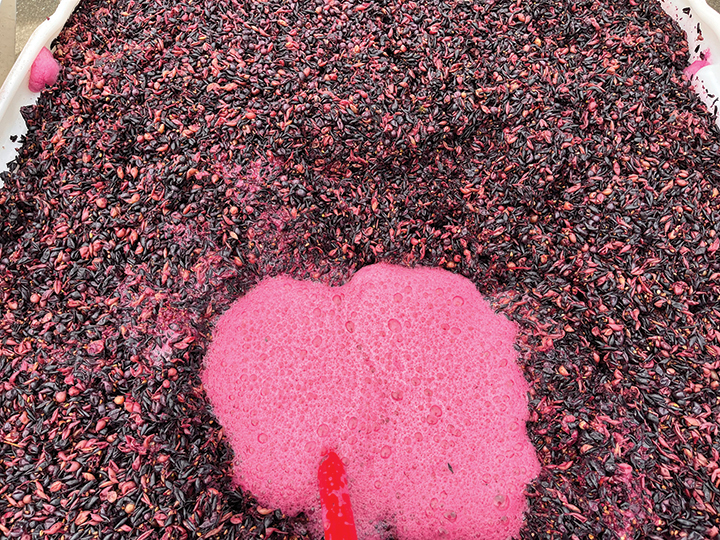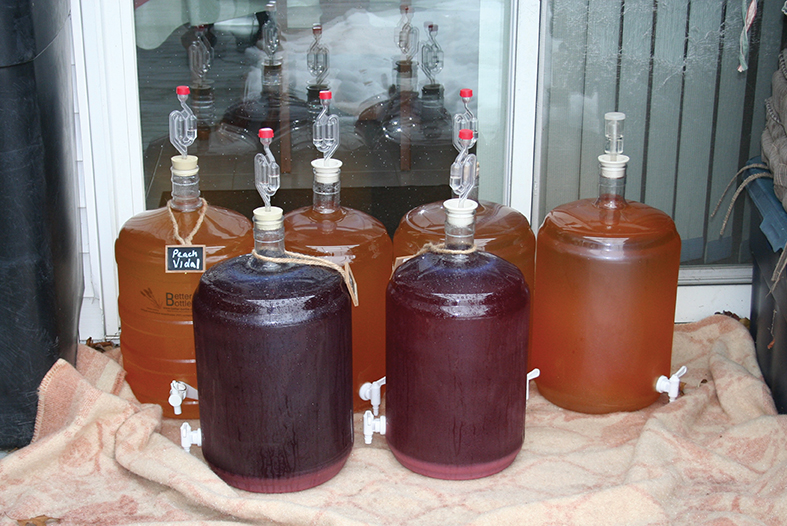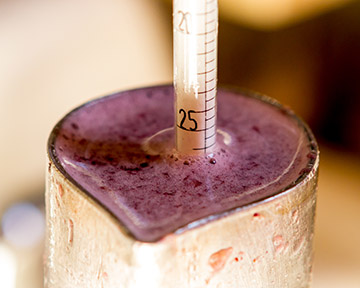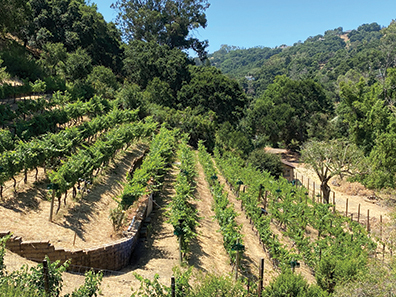The Science of Food and Wine Pairing
“Carignane and goat cheese,” said Tony Ross, wine educator at Passalacqua Winery near Healdsburg, California. During a judging session for a local home wine competition, Tony and I were on the same panel. Between entries, I mentioned working on this “Techniques” column on pairing and he gave me his favorite recommendation. I went on to try out his suggestion on my coworkers (more on that later) and I set out to see if I could bring some scientific principles to bear on this complex subject. We all have favorite food-wine pairings and there are lots of “eat this, drink that” guidelines out there. With a background in the sciences, it is my goal to make such things a bit more predictable. If you know what is going on physiologically and chemically when you taste food and wine, maybe some delightful pairings can come together with a bit less experimentation. Not that there’s anything wrong with experimenting!
In ideal pairings of foods with wines, the experience is enhanced for both. It’s a bit like setting up two of your friends on a blind date — don’t do it unless you are doing them both a favor. It is a good thing if a particular wine makes the food taste better or vice-versa, but the overall pleasure — the hedonistic index, if you will — rises if the combination is better than its parts. The most predictable and reliable technique to achieve a pleasing pairing is to match like with like. That principle forms the basis of many of the conventional pairings that have enjoyed great success since the subject first came under scrutiny in the 19th century. Before that time, people by and large consumed whatever wine was available locally alongside locally produced foods. As it happens, many of these traditional pairings — what grows together, goes together — are still highly valued.
As international commerce expanded and some wealthier consumers had wider access to foods and wines, more choices became available. Combinations “discovered” during this period (says the Larousse Encyclopedia of Wine) include classics like caviar with Champagne, sole with white Burgundy, and game with red Burgundy. Such pairings gave rise to the useful but over-simplified “rule” that white wine goes with fish and red wine goes with meat.
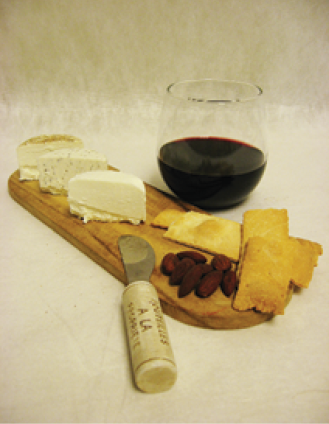
“Like with like” is not the only basic rule, however. Sometimes it is enjoyable to deliberately exceed one characteristic in its match, for instance pairing a very sweet wine with a somewhat less sweet dessert. Also sometimes successful are deliberate contrasts, where the very opposite characteristic in a wine will enhance its pleasure with a contrary food, like a crisp brut Champagne with fatty liver paté. But what is going on in these pairings, classic or not?
Not many pairing guidelines delve into the underlying science and the subject is not thoroughly understood. To get at the principles of food-wine pairings, we need to look at tasting itself. What we call “taste” is a complex combination of the chemical signals of taste receptors in the mouth combined with odor signals from olfactory receptor neurons in the membranes of the nasal cavity. Throughout this column, I will use “taste” in this broad sense. When it comes to pleasurable pairings, it doesn’t particularly matter whether the impressions come from grape smells (aroma), from aging smells (bouquet), or the simple taste bud “tastes.” In perceiving the taste of food, specific receptors in the mouth (primarily on the tongue) detect flavors of salt, sweet, sour, bitter, and perhaps “umami” or savoriness. At the same time, physical changes and effects can be detected as well, such as a coating of fat, a thick or sticky texture, or a hot impression from temperature, alcohol, or spices. It is further estimated that humans can detect 10,000 or so aromas. These aromas reach the receptors not just through the nose, but also through the retronasal passage connecting the mouth with the olfactory center. Thus, as food is chewed and generates “smellable” vapors, the perception of taste changes as these additional or altered aromas are perceived.
In tasting wine, the same physiological equipment is at work, but there are some differences when compared with food. One prominent characteristic of wine is the presence of ethyl alcohol in a significant concentration. With a boiling point of only 173 °F (78 °C), ethyl alcohol is much more volatile than water vapor with a boiling point of 212 °F (100 °C). Warming in the mouth, the ethyl alcohol vapors carry not only their own characteristic aroma but may transport other components to the olfactory sensors as well. In the basic tastes of wine, salt and umami are rare and are not usually considered significant components. On the other hand, sweet, sour, and bitter all play important roles is the perceptions of wine. Any residual sugar directly contributes to a sweet response. At the same time, other wine components such as glycerol or even ethyl alcohol itself may give a sweet impression even in the absence of significant sugar levels. The major sour components of wine are the usual wine acids: tartaric, malic, lactic, and possibly succinic and citric. These acids vary in their specific flavors, but all strongly stimulate the “sour” receptors on the tongue (Warheads® sour candies are coated with malic acid if you would like to try an acid reference experiment on yourself). While pH is an indicator of overall acid activity in the wine, it is the combination of the acid flavors that creates a specific sourness profile. Bitter compounds also occur naturally in wine. Most prominent are the various flavonoids that are derived from the grapes.
Nearly all flavonoid plant components in the diet are bitter, acrid, or astringent. In your wine, their presence is (hopefully) re-strained and they contribute a pleasant complexity.
Just as with food, physical and chemical effects in the mouth also influence the overall perception of wine. Some of the flavonoid compounds, especially the tannins, produce the astringent tannic “grip” or drying sensation that is carried by many wines. In combination, tannins and ethyl alcohol are the primary contributors to overall “body” in a wine.
Along with the individual component tastes of wine or food, we come across various combinations that are easy to name but complex to define, such as fruity, tobacco, leather, smoky, floral, earthy, and others. As with the individual components, we often find a food-wine pairing pleasant if both parts of the pair reflect one or more of these complex groupings.
When planning any food-wine pairing, one fundamental choice is wine first or food first. Sometimes a special new recipe calls for a careful wine choice to highlight the ingredients or cooking skills. Sometimes a special wine is to be presented and you want to show it at its best. Since we are all home winemakers, I will leave it to cooking magazines to highlight the foods. Let’s go with wine first! We have the wine, now let’s choose the food. To do that, we can organize the wine characteristics as we find them and note foods that match or contrast in a pleasant manner with those features.
Here is a possible checklist:
Body
Food-wine pairing guidelines often suggest matching the body of the wine with the weight of the food. That is, serve “full-bodied” wines with robust, powerful, strongly flavored foods. On the other hand, pair “light-bodied” wines with lighter fair; vegetables, mild spicing, perhaps seafood. “Body” partly follows alcohol content, but is strongly moderated by the tannin profile. With no home tests for tannins, you will need to rely on taste to classify your wine.
Acidity
High acid is best handled in a matching manner. Bright, high acid white wines pair best with acidic salad dressings like vinaigrette. If your wine is on the high acid side, consider foods with a corresponding component. In the other direction, acid in wine can help offset fattiness in food. Fatty cheeses or meats can soften the palate effect of that tart wine. Even if the food itself is not fatty, adding a creamy sauce can take it there. Low acid, on the other hand, tends to make a wine seem soft and flabby. In that case, it is good to keep the food profile mild, without extreme spicing or strong flavors. Mild, fruity foods help brighten the wine and counteract the low acid effect. The best indicator of your acid profile is the titratable acidity (TA).
Sweetness
If a wine has noticeable residual sugar, a good pairing is to go with a contrast. Sweetness cools and sooths irritation on the palate, so sweet wines can often pair very well with spicy foods. If a wine is very sweet, it may be suitable to serve with a dessert. The general guideline is to make sure the wine is sweeter than the dessert. If it is not, the contrast may make the wine seem less sweet and take away its major attraction. Very dry wines do not usually pair well with sweet or spicy foods. For them, it is more effective to choose foods that are rich or fatty to contrast with the dryness. Look to your residual sugar numbers (and tasting) to determine the sweetness category of your wine.
Bitterness
If a wine is bitter, you will want a contrast to balance the bitterness and avoid overloading the palate in that direction. Just as we use cream and sugar in black coffee, fat or sweetness in the food can overcome a bitter wine. There are no tests for bitterness, so you are back to your tasting profile for guidance.
Astringency
This drying effect is so closely related to bitterness (in both cause and effect) that they are often confounded together in pairings. An astringent wine will be aided by the same fatty or sweet features that pair well with bitterness. Furthermore, an astringent, tannic wine can add a refreshing cleansing of the palate while consuming fatty foods that tend to coat the tissues. Astringency is also nicely balanced by a strong protein. Here, the same “tanning” of the mouth proteins is turned on the food and the overall impression is one of better balance.
Overall character
This is that elusive “other” category, but most really good pairings handle this in a matching fashion. Fruity wine goes well with fruity food. Smoky wine goes well with smoked meats or cheeses. Earthy wines often prove to be great companions to earthy foods like mushrooms or root vegetables.
How do these principles work in practice? At the annual Taste of Sonoma event in August, my wife and I attended a food-wine pairing seminar presented by Kendall Jackson. They offered four wines, each paired with a small sample of a food prepared by winery chefs. I will describe what they presented, and see if I can deconstruct the pairing principles at work. Then we will look at constructing some prospective matches.
First from Kendall Jackson was a Chardonnay paired with a slice of fried green tomato. The combination was delightful and I think the strongest principle involved was a basic match: acid with acid. The wine was a coastal version, not too oaky, and very bracing in its acid profile. The green tomato, being an unripe fruit, was also high in acid. Adding to the success was a contrast pairing: acid with fat from frying. Fat tends to coat the palate, limiting taste perception in whatever is consumed next. An acidic beverage, however, helps remove the fat, cleansing the palate, and restoring sensitivity. Finally, there was a secondary match that also contributed: an overall herbaceousness. The wine, being from a cool climate, had some “green” notes in the profile. The tomato, also green, emphasized those and made for a pleasant complement.
Second was a Merlot paired with an arancino (a deep-fried rice ball). The rice was a creamy risotto surrounding a small cube of soft fontina cheese. Like the tomato slice, the rice ball was breaded and fried. While both components of this pair were tasty, the combination did not make a very strong impression on me.
The third pairing was much more dramatic; a young, robust Cabernet Sauvignon matched with a lamb slider. Of course, red wine with lamb is a classic and this pair had everything going for it. Alone, the young wine was a bit too tannic. Tasted with the fatty grilled lamb, however, it was toned down to the level of pleasantly clearing the palate. There was also a slightly sweet fruit chutney on the lamb burger that helped elevate the fruit impression from the wine. So the otherwise unbalanced wine was brought around into a wonderful presentation with this inspired pairing. I am not sure the lamb slider was any better than it would have been alone, but the pair was certainly delicious.
Finally, an older Cabernet Sauvignon was presented with a chocolate truffle. This also worked well, first and foremost with the tannins vs. fat effect. As a nice secondary note, earthiness in the more mature wine was enhanced alongside the inherent earthiness of the cocoa powder coating the chocolate truffle.
Now consider some examples for future pairings. As I noted, I tried Tony’s goat cheese and Carignane on my coworkers. With a three-pack of goat crottin (plain, garlic and herb, and four-pepper), I offered a 2008 Cahill Alexander Valley Carignane and a 1999 Homewood Contra Costa County Carignane. For contrast, I poured my own homemade 2011 cool-climate Chardonnay.
Tony was right — this is a very good pairing. While the 1999 wine was clearly past its prime with some browning and Sherry-like notes showing up, both Carignanes still did well with the cheese. The cheeses and the wines were medium in body, neither standing out and quite compatible. The fatty cheese helped round out the wines, giving them an impression of fuller body. At the same time, the moderate acid in the wines seemed to support a bit brighter acid profile in the cheese, making it seem a little less heavy. Some tasters found that the “goatiness” of the cheese overwhelmed the fruitiness of the wine, but others liked the emerging earthiness that the Carignanes revealed from that factor. By comparison, the cool-climate Chardonnay, with high acid and no oak, was universally reviled with the goat cheese. The acid in this wine also emphasized the acid in the otherwise fatty cheese to the point of unbalancing the pair. With the wine completely lacking in earthiness, it had nowhere to stand out with the goat flavors.
For your next pairing, suppose you have made a high acid/low tannin Sangiovese. You don’t want the big roast beef or smoked wild boar with this one — the food would overwhelm the wine. Instead, take advantage of acid, fruit, and moderate tannins by highlighting them. A tomato-based beef sauce like bolognese will give a bright acid pairing while still providing the fattiness that so nicely balances dry red wine.
Another opportunity might come up with a fruity, off-dry rosé. The less-intense meat flavor will not overpower the wine, while the sweet glaze will provide balance and emphasize the fruitiness in the wine.
Finally, consider a big, oaky chardonnay with a high alcohol content. Look to the overall impression of oakiness and match it with smoke. Then, look at the robust body and high alcohol and find something fatty to tame that. A tea-smoked chicken roasted on the rotisserie grill will be perfect.
In the 19th century when worldly rich people and their French chefs were establishing the first “rules,” it was common to serve a different wine with every course. Most of us don’t do that today, so when you show off your homemade wine at a meal, you will probably need to consider more than one dish. My approach is to choose the main dish pairing first and then use the same principles to consider appetizers, side dishes, and desserts.


